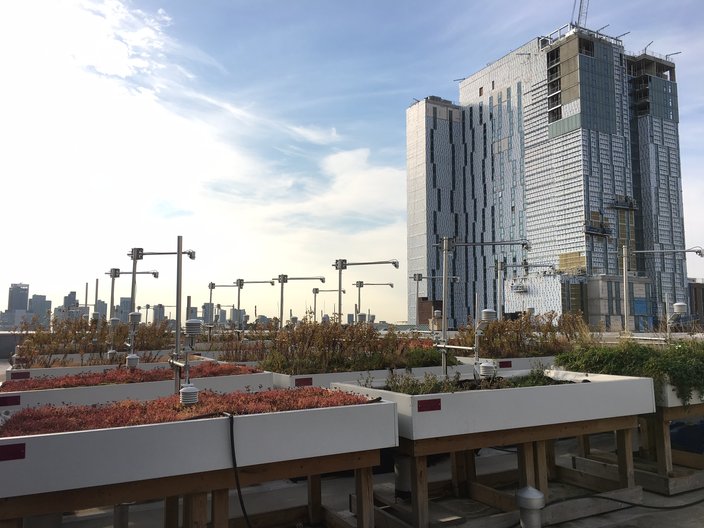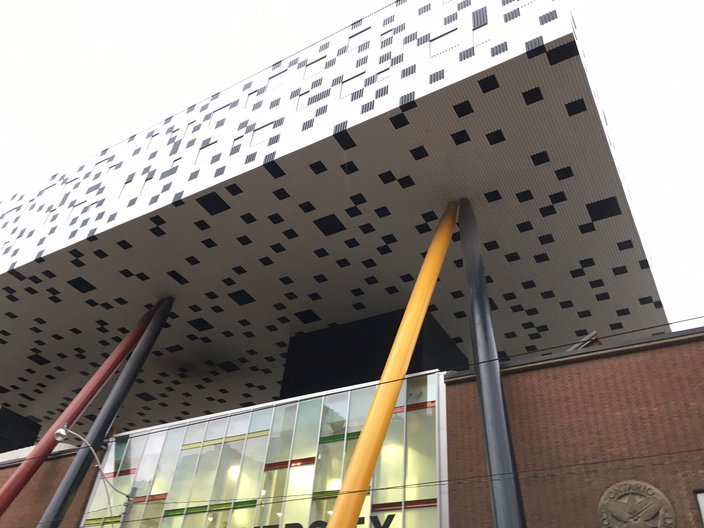10 November 2016
by João Guarantani
ADF's Senior Programme Manager, João Guarantani, who leads on our work in the Americas, visits Canada on a scoping trip and reports back from Toronto.
This is my second ever trip to Canada and I'm excited to be back. My programme, led by Saada El-Akhrass, who runs the British Council's Arts programme in Canada, and supported by our colleague Cleo Sallis, is a packed week of meetings and visits aimed at giving us a fuller picture of what's going on today across Architecture, Design and Fashion in two of Canada's major cities: Toronto and Montreal.
The week starts in Toronto with a visit to Canada's only dedicated design museum, Design Exchange, or DX for short. Housed in Toronto's old stock exchange building and nestled among iconic international style towers designed by Mies van der Rohe, DX runs a year-long programme of exhibitions, talks and events promoting Canadian and international design. Overall, I'm impressed by the wealth of design on offer across Toronto, despite the apparent lack of exhibition spaces formally devoted to the discipline, amongst these the Bata Shoe Museum, with an informative (if perhaps a little stale) permanent collection and two excellent temporary exhibitions - when we visited, the show dedicated to shoes across the Arctic was extremely impressive, both in its content and presentation.
Another great example of exhibition programmes on offer in Toronto is the Gardiner Museum, with its impressive international collection of historical and contemporary ceramics. Again, the temporary exhibition was testament to the caliber of shows mounted here, and masterfully traced the influence of Scandinavian design on the work of Canadian designers in the post-war years.
Our programme then leads us to various conversations around the strength of (and at times what's lacking for) the Fashion industry in Canada - first, a warm welcome by Susan Langdon, who for years has been at the helm of the Toronto Fashion Incubator, aka TFI, the first such initiative in the world commissioned for and funded by (at least in its early years) by a city hall. With a focus on supporting emerging talent, TFI runs a number of business and skills programmes for the local fashion sector, and offers studio space for a cohort of designers in its quirky early 20C building on the edge of Toronto.
I sense a certain momentum with a number of contacts mentioning the need for the sector to come together to strengthen its lobbying power with government and financing partners. Fashion Group International seems to be leading on this, proposing to bring together different strands of the industry under one coherent umbrella. I look forward to seeing what they come up with in the next few years and hope that British designers can be part of this journey, too.
One of the most interesting conversations so far, has been, undoubtedly, with Sage Paul, practising in the often tenuous gap between fashion and fine art. A few years ago, Sage founded Setsuné Indigenous Fashion Incubator, which aims to create a range of opportunities for designers from indigenous backgrounds. Canada seems to have turned an important corner in recent years with regards to celebrating the importance and relevance of different cultural expressions by its First Nation groups, and I'm thrilled to see some good work being done to bring fashion under this banner too. It must be said, however, that whilst interest seems to be on the rise, more is needed to support and finance initiatives by Setsuné and others, but my chat with Sage leaves me very optmistic - perhaps it's her infectious energy!
My time in Toronto is running out, and before departing for Montreal I meet with Toronto Design Offsite Festival (TO DO), which is fast becoming the main showcase of local and international design in the city's cultural calendar. Taking place each [chilly] January, TO DO is, like other design festivals, an umbrella programme featuring a handful of landmark projects alongside self-initiated satellite events and exhibitions. I'm inspired by their ambitious outlook, and hope TO DO can join us on Design Connections in a not-too-distant future and that their programme becomes, more and more, a window into cutting edge design from Canada - Canadian designers deserve a platform to showcase their wares.
We then visit one of TO DO's partner institutions, Harbourfront Centre,with its impressive craft and design studios and exhibition facilities. Another example of the city's long-term vision for the creative industries, the Centre was created over 20 years ago as a multidisciplinary arts venue across a 30-acre site. I'm excited to see the vital role the complex's impressive craft and design studios play in the life of the Centre, offering affordable state-of-the-art facilities for a range of craft and design professionals working in all sorts of disciplines, from ceramics and glass making, to illustration and digital design.
In the last leg of my stay here I head to two of Canada's leading architecture and design schools: first, we visit OCAD'sWill Alsop-designed faculty building in the heart of Toronto. Loved and hated in equal measure - or so I'm told -, this colourful 'matchbox on stilts' is both a landmark and a thriving space for Toronto's growing design scene. Finally, we're welcomed by Liat Margolis, Associate Professor at the John H. Daniels Faculty of Architecture, Landscape and Design at the University of Toronto. Besides an inspiring conversation about potential live projects, residencies and charettes we could develop together, I'm lucky to get a private tour of their impressive GRIT lab (Green Roof Innovation Testing), unique in the world. GRIT effectively tests a range of current and emerging sustainable building technology, with very interesting and at times challenging results.
I'm impressed by the scene here, and no doubt there'll be even more to come once we hit Montreal!





